In a groundbreaking study, researchers have identified novel candidate genes potentially responsible for congenital deafness, a condition affecting approximately one in every 1,000 newborns in the UK. This revelation has significant implications for understanding the genetic basis of hearing loss, which is crucial for developing effective therapies aimed at mitigating its impact on communication, social interaction, and cognitive development in children.
Congenital deafness is primarily caused by mutations in specific genes, but many of these mutations remain undiscovered, leaving a significant gap in our understanding of the genetic underpinnings of this condition. This lack of knowledge has hindered the development of targeted treatment strategies and interventions for those affected. Researchers have long recognized that deciphering the mutations responsible for hearing loss holds the key to unlocking potential treatments that could dramatically improve the quality of life for affected individuals.
Professor Andrea Streit, a noted expert in developmental neurobiology from King’s College London, emphasized the importance of this research. She noted that human genetics has already identified hundreds of regions on chromosomes associated with deafness, known as “deafness loci.” However, the challenge lies in pinpointing the specific gene within these loci that, when mutated, leads to hearing impairment. This complicates the diagnostics and treatment of deafness, as genetic testing may indicate the presence of mutations without elucidating their clinical significance.
The recent study, spearheaded by King’s College London in collaboration with researchers at George Washington University, sought to bridge this gap by identifying new candidate genes contributing to congenital deafness. The investigative team concentrated their efforts on a protein known as Six1, which was previously linked to hearing loss. Their aim was to delineate the genes regulated by Six1 and to assess their potential role in hearing impairment.
Employing advanced computer-based methods, the researchers predicted over 150 potential target genes regulated by the Six1 protein within ear progenitor cells derived from chick embryos. This predictive model laid the groundwork for a focused investigation into four specific target genes. These genes were of particular interest due to their expression profiles and their relevance to ear development.
Following the selection of these four targets, the researchers delved deeper, demonstrating that Six1 binds to the regulatory DNA regions that control the expression of these genes. They discovered that reducing levels of Six1 led to a marked decrease in the activation of these crucial genes, thereby suggesting a direct regulatory role for Six1 in ear progenitor cells. This finding reinforces the hypothesis that variations in Six1 expression could significantly impact ear development and, consequently, auditory function.
Further analysis revealed a striking concordance between the gene expression patterns observed in chick embryos and those present in human ear progenitors. Notably, around 25% of the identified genes exhibited localization within chromosomal regions previously associated with deafness. This correlation positions these genes as priority candidates for further studies aimed at determining their causal relationship to congenital hearing loss. Such genetic links are pivotal, as they could fundamentally shift the landscape of genetic testing for hearing impairments.
Professor Streit remarked on the significance of the conserved nature of the DNA regions that regulate Six1 target genes across species, highlighting both birds and humans. This evolutionary conservation suggests that the molecular mechanisms governed by Six1 in ear development have remained stable over 600 million years of evolutionary history. Such a length of time underscores the critical biological processes controlled by these regulatory genes, indicating their fundamental roles in developmental biology.
Moreover, the researchers postulated that an in-depth exploration of Six1, along with the genes it regulates, could yield further insights into the molecular mechanisms that dictate normal ear development. Understanding these mechanisms not only holds promise for elucidating the genetic basis of congenital deafness but also opens new avenues for potential interventions that could alter the trajectory of hearing loss in affected individuals.
In conclusion, the findings from this study not only identify promising candidate genes involved in congenital deafness but also reinforce the critical role of genetic research in understanding complex conditions. As scientists continue to unravel the intricate genetic networks governing ear development and function, the hope for targeted therapies to mitigate the impacts of hearing loss becomes increasingly feasible. This pioneering research underscores the power of collaborative efforts in advancing our understanding of genetic disorders and emphasizes the essential need for ongoing investigations in this crucial area of health and medicine.
The implications of these findings extend beyond the field of genetics, as they resonate within the broader context of developmental neuroscience and cognitive psychology. As the researchers continue their investigations into the molecular regulation of hearing, the potential for therapeutic interventions becomes ever more promising, paving the way for a future where congenital deafness can be effectively managed or even prevented.
Through the identification of novel candidate genes and the elucidation of their roles in congenital deafness, this research marks a significant step forward in the scientific journey toward unraveling the complexities of genetic hearing loss. It inspires hope for affected families and emphasizes the critical nature of continued research in understanding and addressing one of the most prevalent sensory disorders affecting individuals worldwide.
Subject of Research: Candidate genes responsible for congenital deafness
Article Title: Identification of Novel Candidate Genes Linked to Congenital Deafness
News Publication Date: October 2023
Web References: www.kcl.ac.uk, www.gwu.edu
References: DOI: 10.1242/dev.204533
Image Credits: King’s College London
Keywords: Deafness, Genetics, Congenital Hearing Loss, Six1, Gene Regulation, Developmental Biology, Molecular Mechanisms, Ear Development, Evolutionary Conservation, Therapeutic Interventions, Candidate Genes.




